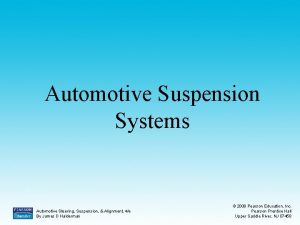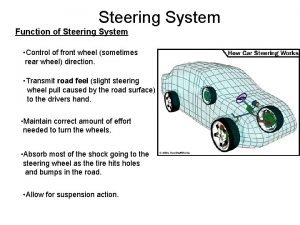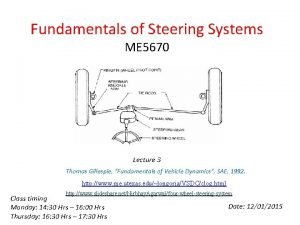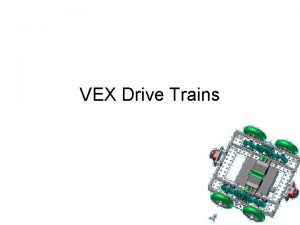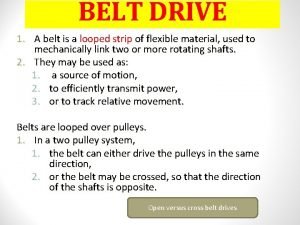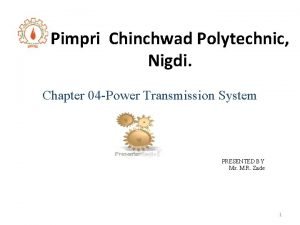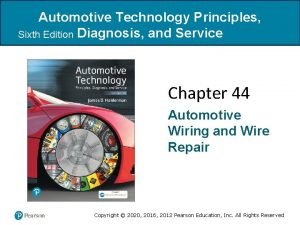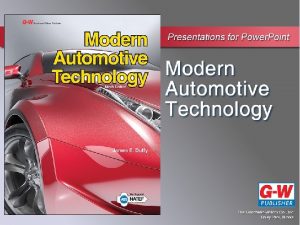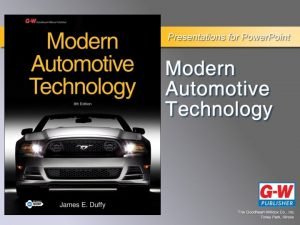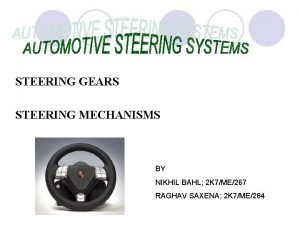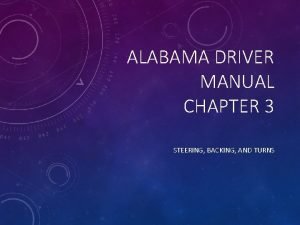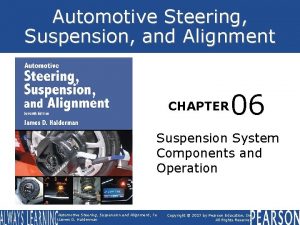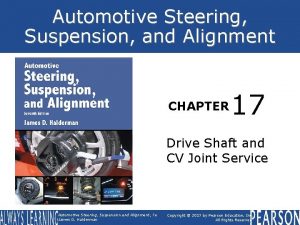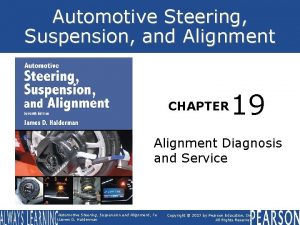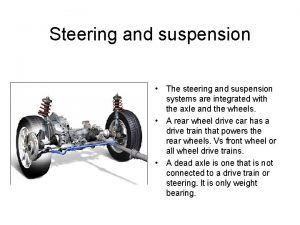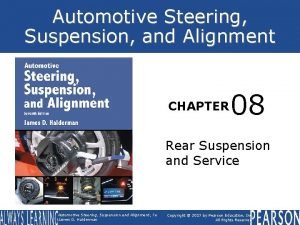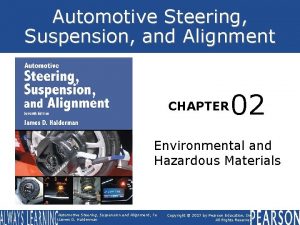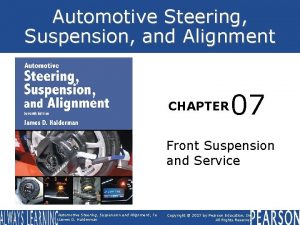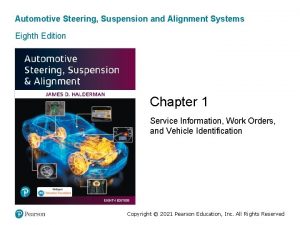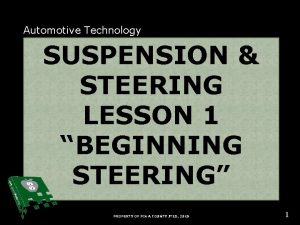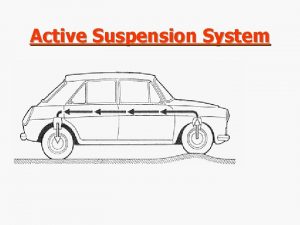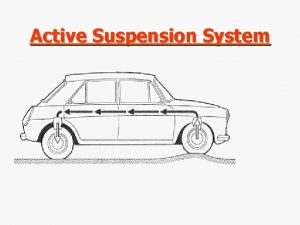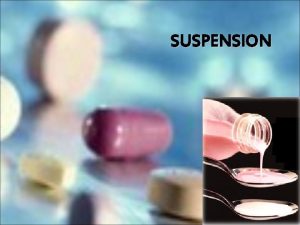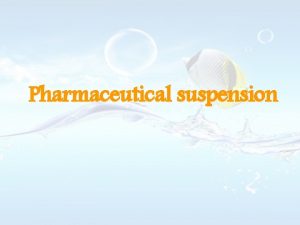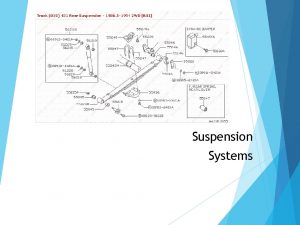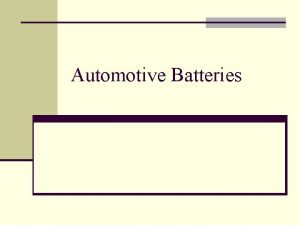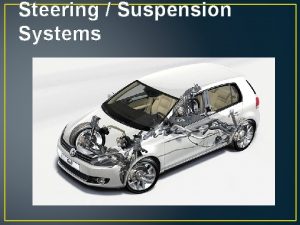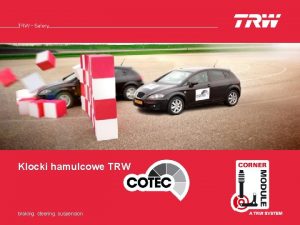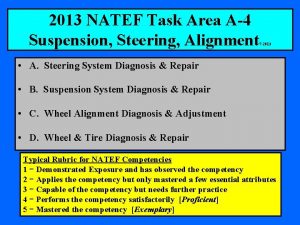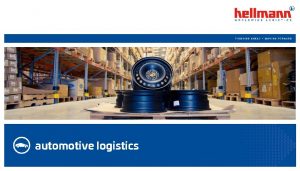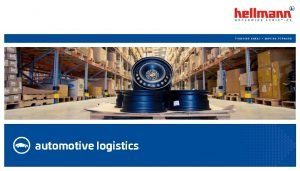Automotive Steering Suspension and Alignment CHAPTER 16 Drive
























- Slides: 24

Automotive Steering, Suspension, and Alignment CHAPTER 16 Drive Shafts and CV Joints Automotive Steering, Suspension and Alignment, 7 e James D. Halderman Copyright © 2017 by Pearson Education, Inc. All Rights Reserved

FIGURE 16. 1 Typical rear-wheel-drive powertrain arrangement. The engine is mounted longitudinal (lengthwise). Automotive Steering, Suspension and Alignment, 7 e James D. Halderman Copyright © 2017 by Pearson Education, Inc. All Rights Reserved

FIGURE 16. 2 Typical front-wheel-drive powertrain arrangement. The engine is usually mounted transversely (sideways). Automotive Steering, Suspension and Alignment, 7 e James D. Halderman Copyright © 2017 by Pearson Education, Inc. All Rights Reserved

FIGURE 16. 3 Typical driveshaft (also called a propeller shaft). The drivershaft transfers engine power from the transmission to the differential. Automotive Steering, Suspension and Alignment, 7 e James D. Halderman Copyright © 2017 by Pearson Education, Inc. All Rights Reserved

FIGURE 16. 4 This driveshaft was found to be dented during a visual inspection and has to be replaced. Automotive Steering, Suspension and Alignment, 7 e James D. Halderman Copyright © 2017 by Pearson Education, Inc. All Rights Reserved

FIGURE 16. 5 A center support bearing is used on many vehicles with long two-part driveshafts. Automotive Steering, Suspension and Alignment, 7 e James D. Halderman Copyright © 2017 by Pearson Education, Inc. All Rights Reserved

FIGURE 16. 6 Some driveshafts use rubber between an inner and outer housing to absorb vibrations and shocks to the driveline. Automotive Steering, Suspension and Alignment, 7 e James D. Halderman Copyright © 2017 by Pearson Education, Inc. All Rights Reserved

FIGURE 16. 7 A simple universal joint (U-joint). Automotive Steering, Suspension and Alignment, 7 e James D. Halderman Copyright © 2017 by Pearson Education, Inc. All Rights Reserved

FIGURE 16. 8 How the speed difference on the output of a typical U-joint varies with the speed and the angle of the U-joint. Automotive Steering, Suspension and Alignment, 7 e James D. Halderman Copyright © 2017 by Pearson Education, Inc. All Rights Reserved

FIGURE 16. 9 The joint angle is the difference between the angles of the joint. Automotive Steering, Suspension and Alignment, 7 e James D. Halderman Copyright © 2017 by Pearson Education, Inc. All Rights Reserved

FIGURE 16. 10 The angle of this rear Cardan U-joint is noticeable. Automotive Steering, Suspension and Alignment, 7 e James D. Halderman Copyright © 2017 by Pearson Education, Inc. All Rights Reserved

FIGURE 16. 11 A double-Cardan U-joint. Automotive Steering, Suspension and Alignment, 7 e James D. Halderman Copyright © 2017 by Pearson Education, Inc. All Rights Reserved

FIGURE 16. 12 A constant velocity (CV) joint can operate at high angles without a change in velocity (speed) because the joint design results in equal angles between input and output. Automotive Steering, Suspension and Alignment, 7 e James D. Halderman Copyright © 2017 by Pearson Education, Inc. All Rights Reserved

FIGURE 16. 13 A Rzeppa fixed joint. This type of CV joint is commonly used at the wheel side of the drive axle shaft. This joint can operate at high angles to compensate for suspension travel and steering angle changes. Automotive Steering, Suspension and Alignment, 7 e James D. Halderman Copyright © 2017 by Pearson Education, Inc. All Rights Reserved

FIGURE 16. 14 The protective CV joint boot has been torn away on this vehicle and all of the grease has been thrown outward onto the brake and suspension parts. Automotive Steering, Suspension and Alignment, 7 e James D. Halderman Copyright © 2017 by Pearson Education, Inc. All Rights Reserved

FIGURE 16. 15 A tripod fixed joint. This type of joint is found on some Japanese vehicles. If the joint wears out, it is to be replaced with an entire drive axle shaft assembly. Automotive Steering, Suspension and Alignment, 7 e James D. Halderman Copyright © 2017 by Pearson Education, Inc. All Rights Reserved

FIGURE 16. 16 The fixed outer joint is required to move in all directions because the wheels must turn for steering as well as move up and down during suspension movement. Automotive Steering, Suspension and Alignment, 7 e James D. Halderman Copyright © 2017 by Pearson Education, Inc. All Rights Reserved

FIGURE 16. 17 Unequal-length driveshafts result in unequal drive axle shaft angles to the front drive wheels. This unequal angle side to side often results in a steering of the vehicle during acceleration called torque steer. Automotive Steering, Suspension and Alignment, 7 e James D. Halderman Copyright © 2017 by Pearson Education, Inc. All Rights Reserved

FIGURE 16. 18 A typical drive axle shaft with dampener weight. Automotive Steering, Suspension and Alignment, 7 e James D. Halderman Copyright © 2017 by Pearson Education, Inc. All Rights Reserved

FIGURE 16. 19 A tripod joint is also called a tripot, tripode, or tulip design. Automotive Steering, Suspension and Alignment, 7 e James D. Halderman Copyright © 2017 by Pearson Education, Inc. All Rights Reserved

FIGURE 16. 20 A cross-groove plunge joint is used on many German front-wheel-drive vehicles and as both inner and outer joints on the rear of vehicles that use an independent-type rear suspension. Automotive Steering, Suspension and Alignment, 7 e James D. Halderman Copyright © 2017 by Pearson Education, Inc. All Rights Reserved

FIGURE 16. 21 Double-offset ball-type plunge joint. Automotive Steering, Suspension and Alignment, 7 e James D. Halderman Copyright © 2017 by Pearson Education, Inc. All Rights Reserved

FIGURE 16. 22 Getting the correct boot kit or parts from the parts store is more difficult on many Chrysler front-wheel-drive vehicles because Chrysler has used four different manufacturers for its axle shaft assemblies. Automotive Steering, Suspension and Alignment, 7 e James D. Halderman Copyright © 2017 by Pearson Education, Inc. All Rights Reserved

FIGURE 16. 23 Many CV joints are close to the exhaust system where they are exposed to higher than normal temperatures. Automotive Steering, Suspension and Alignment, 7 e James D. Halderman Copyright © 2017 by Pearson Education, Inc. All Rights Reserved
 Halderman
Halderman Steering system
Steering system Googlehttps://drive.google.com/drive/my-drive
Googlehttps://drive.google.com/drive/my-drive Https://slidetodoc.com
Https://slidetodoc.com Rit google drive
Rit google drive Steering and suspension system
Steering and suspension system Global alignment and local alignment
Global alignment and local alignment Global alignment vs local alignment
Global alignment vs local alignment Pam1250
Pam1250 Sequence alignment
Sequence alignment Jonathan pevsner
Jonathan pevsner Vex drive trains
Vex drive trains The fixed point in axial suspension is
The fixed point in axial suspension is Crossed belt drive
Crossed belt drive Difference between open belt drive and cross belt drive
Difference between open belt drive and cross belt drive Performing basic maneuvers chapter 4
Performing basic maneuvers chapter 4 Chapter 44 automotive wiring and wire repair
Chapter 44 automotive wiring and wire repair Chapter 2 automotive careers and ase certification
Chapter 2 automotive careers and ase certification 1https://drive.google.com/drive/u/1
1https://drive.google.com/drive/u/1 Https drive google com
Https drive google com Https drive google com drive u 0 recent
Https drive google com drive u 0 recent Automotive technology chapter 51 answers
Automotive technology chapter 51 answers Chapter 76 suspension system diagnosis and repair answers
Chapter 76 suspension system diagnosis and repair answers Cam and peg steering gear
Cam and peg steering gear What is push pull feed steering
What is push pull feed steering
